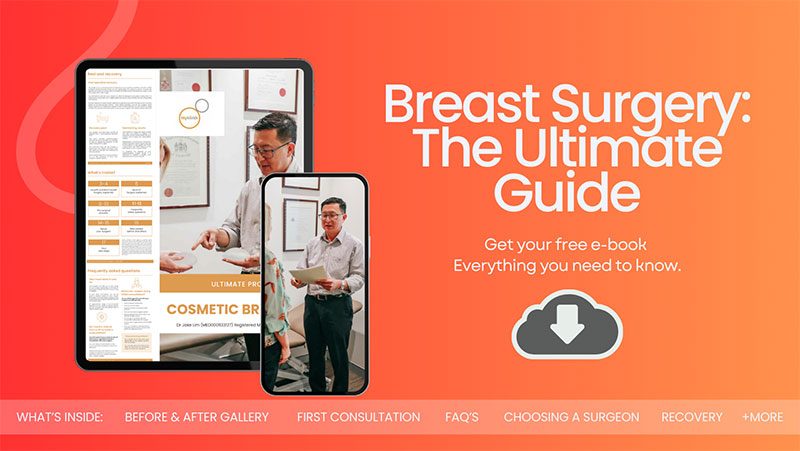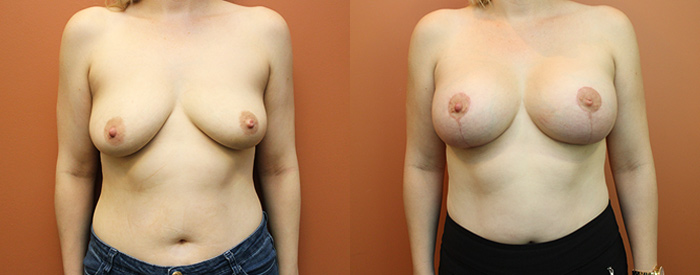Correcting Congenital Breast Deformities with Mastopexy
Tuberous breasts can lead to asymmetry and discomfort. But there are solutions to correct this congenital breast deformity.
Dr Jake Lim, a Sydney Specialist Plastic Surgeon, has many years of experience correcting congenital breast deformities through mastopexy (breast lift) and other techniques.
Download Dr Lim’s Ultimate Breast Surgery Guide

What are Tuberous Breasts?
Tuberous breasts, also known as tubular breasts or constricted breasts, are a developmental breast deformity that affects the shape and appearance of the breasts. This condition is characterised by a range of aesthetic and structural abnormalities that can cause significant distress for those affected.
Characteristics of Tuberous Breasts
Tuberous breasts are a result of a developmental abnormality that occurs during puberty. The breasts appear elongated, cylindrical, or tube-like, with a narrow base and a high, tight lower pole. Some of the common characteristics of tuberous breasts include:
- Abnormally small or constricted breast base
- Enlarged, protruding, or puffy areolas
- Asymmetry between the breasts
- Insufficient breast tissue volume
- High, tight inframammary fold (the crease under the breast)
- Sagging or drooping appearance of the breasts
These characteristics can vary in severity from person to person, and the condition may affect one or both breasts.
Causes of Tuberous Breasts
Tuberous breasts are a congenital deformity, meaning that the condition is present from birth. The exact cause of this deformity is not fully understood, but it is believed to be related to a defect in the formation of the breast tissue during embryonic development. This defect may be due to genetic factors, hormonal imbalances, or a combination of both.
During puberty, when the breasts typically develop, the abnormal breast tissue in tuberous breasts fails to expand and grow properly. The breast tissue remains constricted at the base, leading to the characteristic elongated, tubular shape. Additionally, the areola may be disproportionately large and protrude due to the lack of underlying breast tissue support.
It’s important to note that tuberous breasts are not caused by any external factors or lifestyle choices. They are a congenital condition that cannot be prevented or caused by any specific actions or behaviours.
Different Types and Grades of Tuberous Breasts
Tuberous breasts can present in different forms and varying degrees of severity. The classification of tuberous breasts is based on the extent of the deformity and the specific characteristics exhibited. The most common classification system, known as the Von Heimburg classification, divides tuberous breasts into four grades:
- Grade I: The breasts have a mild deformity, with a slightly constricted base and minimally enlarged areolas. The breast tissue volume is relatively normal.
- Grade II: The breasts have a moderate deformity, with a more constricted base and enlarged areolas. The breast tissue volume is often insufficient, and there may be mild asymmetry between the breasts.
- Grade III: The breasts have a severe deformity, with a significantly constricted base, greatly enlarged areolas, and a marked deficiency in breast tissue volume. Asymmetry between the breasts is often more pronounced.
- Grade IV: The breasts have an extreme deformity, with a severely constricted base, massively enlarged areolas, and a severe lack of breast tissue volume. The breasts may appear almost absent, with significant asymmetry.

Correcting Tuberous Breasts with Mastopexy (Breast Lift)
Mastopexy, commonly known as a breast lift, is a surgical procedure that can effectively correct the appearance of tuberous breasts. This surgery addresses the specific issues associated with tuberous breasts, helping women achieve a more natural breast shape.
How Is a Mastopexy Surgery Performed?
Mastopexy is a surgical technique designed to lift and reshape sagging or poorly shaped breasts. The procedure involves removing excess skin, repositioning the nipple-areola complex to a higher position, and reshaping the breast tissue to create a proportionate breast contour.
During a mastopexy for tuberous breasts, Dr Jake Lim will begin by making strategic incisions around the areola, vertically down to the breast crease, and sometimes along the inframammary fold. The specific incision pattern will depend on the severity of the tuberous breast deformity and the desired degree of correction.
Through these incisions, Dr Lim will carefully release the constricted breast tissue, allowing it to expand and take on a more natural shape. He will then redistribute the breast tissue to create a fuller, more rounded appearance, paying close attention to achieving symmetry between the breasts. The nipple-areola complex will be repositioned higher on the breast mound, and any excess skin will be removed to create a tighter breast contour.
The incisions will be closed with sutures, and a supportive dressing will be applied to promote healing and maintain the new breast shape.
How Mastopexy Addresses the Specific Issues Related to Tuberous Breasts
Mastopexy is particularly well-suited for correcting the unique challenges posed by tuberous breasts.
- Constricted Breast Base: During the mastopexy procedure, Dr Lim will release the constricted breast tissue at the base, allowing the breast to expand and take on a more natural shape. This step is crucial in correcting the elongated, tubular appearance of tuberous breasts.
- Enlarged or Protruding Areolas: As part of the mastopexy, the areolas can be resized and reshaped to achieve a more proportionate appearance. Any excess areolar skin will be removed, and the areolas will be repositioned to a higher position on the breast mound.
- Insufficient Breast Tissue Volume: While mastopexy alone does not significantly increase breast volume, it can help redistribute the existing breast tissue to create a fuller, more rounded appearance. By reshaping the breast tissue and creating a more proportionate breast contour, mastopexy can improve the overall aesthetic of the breasts.
- Breast Asymmetry: Mastopexy can be performed on one or both breasts to address any asymmetry caused by tuberous breasts. Dr Lim will carefully assess the individual characteristics of each breast and tailor the procedure to achieve the best possible symmetry between the breasts.
Benefits of Combining Mastopexy with Other Procedures
While mastopexy alone can significantly improve the appearance of tuberous breasts, some women may benefit from combining the procedure with other surgical techniques for optimal results. One common combination is mastopexy with breast augmentation – augmentation mammoplasty.
Breast augmentation involves the use of implants to increase breast volume and alter the overall shape of the breasts. When combined with mastopexy, augmentation mammoplasty can help achieve a more visible transformation in cases of tuberous breasts with significant volume deficiency. The implants can provide the necessary volume to fill out the breasts, while the mastopexy reshapes the breast tissue and corrects any sagging or abnormalities.
The decision to combine mastopexy with other procedures will depend on your individual needs, goals, and the recommendations of your plastic surgeon. Dr Jake Lim will carefully assess your specific case and discuss the best treatment options to help you achieve the results you desire.
What Other Congenital Breast Deformities Can Be Corrected with Mastopexy?
In addition to tuberous breasts, mastopexy (breast lift) can be used to correct various other congenital breast deformities, such as:
- Poland Syndrome: Poland syndrome is a rare congenital disorder characterised by the underdevelopment or absence of the chest muscle (pectoralis) on one side of the body, often accompanied by breast and nipple abnormalities. Women with Poland syndrome may have a significantly smaller or absent breast on the affected side, as well as a misshapen or displaced nipple-areola complex. Mastopexy can be used to reshape the existing breast tissue, reposition the nipple-areola complex, and create a more symmetrical appearance. In some cases, mastopexy may be combined with breast augmentation or fat grafting to address volume deficiencies.
- Breast Asymmetry: Congenital breast asymmetry occurs when there is a significant difference in the size, shape, or position of the breasts. While some degree of asymmetry is common and normal, severe cases can cause emotional distress and practical difficulties with clothing and bra fit. Mastopexy can be performed on one or both breasts to correct asymmetry, reshaping the breast tissue and repositioning the nipple-areola complex to achieve a more balanced and harmonious appearance. In some cases, differential breast reduction – reduction mammoplasty or augmentation may be combined with mastopexy to further improve symmetry.
- Inverted Nipples: Inverted nipples are a congenital condition in which the nipples are retracted into the breast instead of pointing outward. This can cause difficulties with breastfeeding. During a mastopexy, inverted nipples can be surgically corrected by releasing the tethered tissue causing the inversion and reshaping the nipple to achieve a more projecting, natural appearance.
- Oversized or Misshapen Areolas: Some women may have congenitally oversized or misshapen areolas. During a mastopexy, the areolas can be resized and reshaped to achieve a more proportionate appearance. The excess areolar skin is removed, and the areolas are repositioned to a higher position on the breast mound.
FAQs about Breast Lift – Mastopexy and Tuberous Breasts

Can mastopexy correct asymmetry caused by tuberous breasts?
- Yes, mastopexy can be performed on one or both breasts to address asymmetry caused by tuberous breasts. Dr Jake Lim will carefully assess the individual characteristics of each breast and tailor the procedure to achieve the best possible symmetry between the breasts.
Is there a specific age requirement for undergoing mastopexy for tuberous breasts?
- There is no specific age requirement for mastopexy, but it is generally recommended that patients wait until their breasts have fully developed, which typically occurs around the age of 18. It’s also important to consider factors such as overall health, emotional maturity, and realistic expectations before undergoing the procedure.
Will I have visible scars after a mastopexy for tuberous breasts?
- As with any surgical procedure, mastopexy will result in some scarring. However, Dr Lim uses different techniques and carefully places the incisions to reduce the appearance of scars. The extent and location of the scars will depend on the specific incision pattern used, which can vary based on the severity of the tuberous breast deformity and the desired degree of correction.
How long does it take to recover from a mastopexy for tuberous breasts?
- The recovery time after a mastopexy for tuberous breasts can vary depending on the individual and the extent of the procedure. Most patients can return to light activities and desk work within 1-2 weeks, but strenuous exercise and heavy lifting should be avoided for at least 4-6 weeks. It’s important to follow Dr Lim’s postoperative instructions carefully to ensure proper healing and optimal results.
Further Reading about Breast Lift – Mastopexy with Sydney Specialist Plastic Surgeon Dr Jake Lim
- Read Dr Lim’s Blog about Breast Lift Techniques – Which One Is Right for You
- Read Dr Lim’s Blog about Breast Lift (Mastopexy) without Implants: Expectations vs. Reality
- Read Dr Lim’s Blog about Can a Breast Lift – Mastopexy Improve Nipple Position?
- Read Dr Lim’s Blog about Breast Lift Surgery – Myths and Facts
- Read Dr Lim’s Blog about Combining Breast Lift (Mastopexy) with Augmentation: Pros and Cons
- Read Dr Jake Lim’s Blog about Inverted Nipples – Causes and Treatment
Medical References for Breast Lift – Mastopexy and Tuberous Breasts
- Tubular Breasts: What They Are, Causes & Treatment
- Tuberous Breast Management: A Review of Literature and Novel Technique Refinements
- Review of Tuberous Breast Deformity: Developments over the Last 20 Years
- The Different Surgical Strategies for Treating Tuberous Breast Deformity: A Scoping Review
- The Prevalence of Tuberous/Constricted Breast Deformity in Population and in Breast Augmentation and Reduction Mammaplasty Patients




